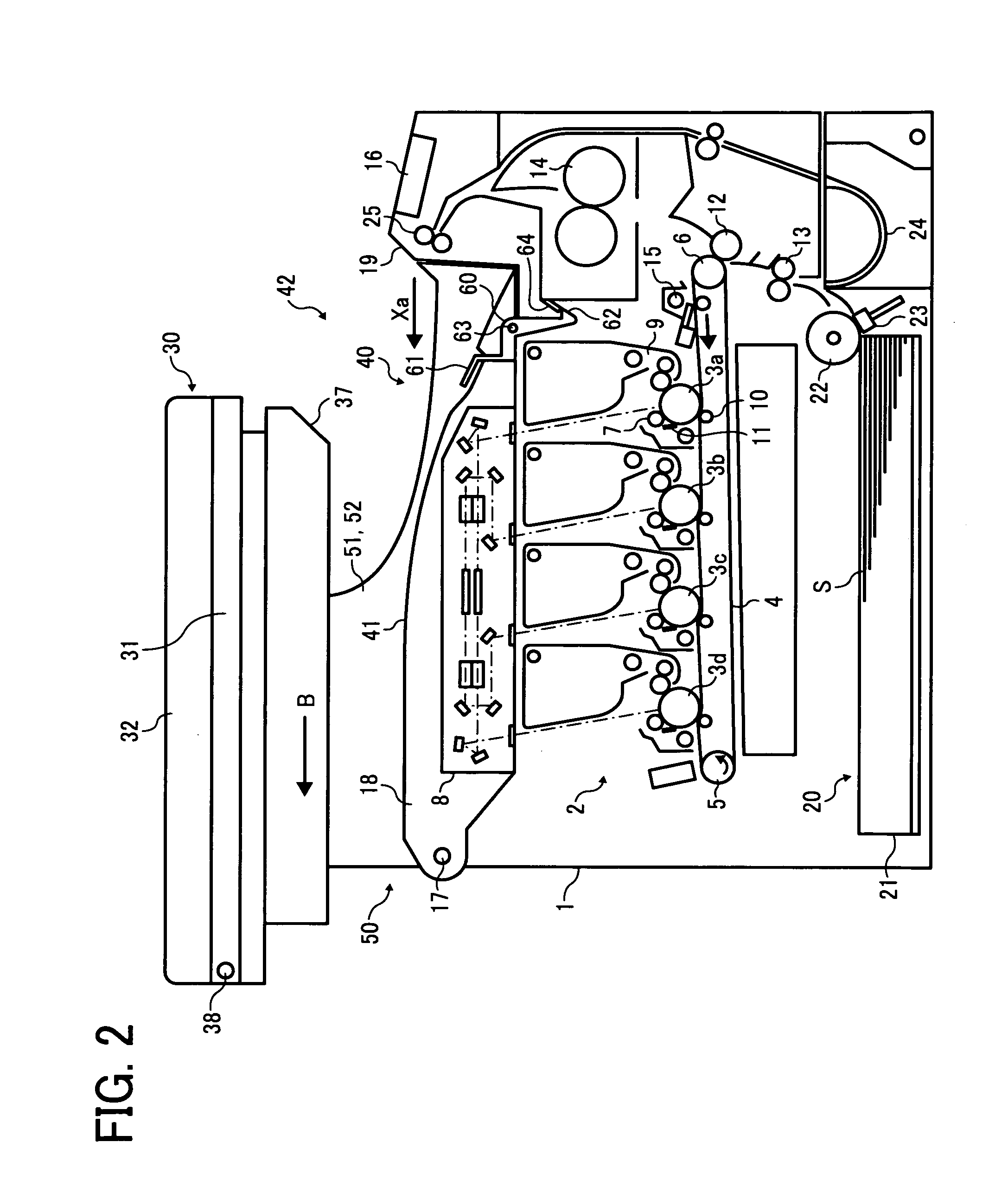In general, such cavity type image forming apparatuses have an
advantage of space-saving, but have drawbacks such that the copy sheets on the copy tray cannot be well observed by operators (i.e., the
visibility of the copy sheets is bad), and poor
discharge properties such that jamming of the copy sheets tends to occur at the copy tray, and a large amount of copy sheets cannot be stored in the copy tray.
The image forming apparatus has the following drawbacks:(1) Since the upper unit extends toward the exit of the copy tray, the
visibility of the copy sheets on the copy tray (hereinafter referred to as copy
visibility) is bad.(2) When replacing the process
cartridge and / or transfer unit, the copy tray has to be opened after opening the upper unit, wherein the copy tray and the upper unit have different pivot axes.
Thus, the image forming apparatus has complex configuration.
Since the transfer unit is pivoted together with the pivoted unit, it is necessary to open the unit at a
high angle to replace the consumable supplies.(3) Since the exit of the copy tray is positioned on a relatively high level and the flat surface of the copy tray is located on a relatively low level while the upper unit extends toward the exit of the copy tray, the copy visibility is bad.(4) When replacing the toner
bottle, the upper unit and the copy tray have to be pivoted.
In addition, the gap between the surface of the copy tray and the upper surface of exit of the copy tray is small, and therefore a large amount of copy sheets cannot be stored on the copy tray.
Further, the copy sheets cannot be well observed from the front side of the image forming apparatus.(5) Although the upper unit can be slid to replace the toner
bottle, the copy visibility cannot be improved thereby.(6) The
scanner is easily pivoted and opened when receiving an upward force.(7) The image forming apparatus uses a number of parts such as slide rails and rollers, resulting in increase of the manufacturing costs.(8) There is a risk such that operator's fingers are wedged between the
scanner and the image forming when the
scanner is slid.
Therefore, the copy visibility is not good.
Therefore, when a small-size copy sheet is produced, the copy sheet on the copy tray cannot be absolutely observed from the front side of the apparatus because the exit of the copy tray is located on a relatively high level compared to the copy discharging exit through which copy sheets are discharged to the copy tray from the main body.
Therefore, when jamming occurs, it is not easy to remove the jammed sheet from the apparatus.
Particularly, in a case where a small-size copy sheet is jammed, the jammed sheet cannot be accessed unless the scanner is opened while pivoted.
In addition, it is difficult to take such a small-size copy sheet from the copy tray unless the scanner is opened while pivoted.
Thus, it is troublesome to take a copy sheet from the copy tray.
Although an openable and closable window is provided on an upper support of the image forming section to improve the copy visibility, copy sheets on the tray cannot be accessed unless a hand is inserted from the side of the apparatus, and it is troublesome to take out the copy sheet.
In addition, the operation panel of the apparatus which is provided on the upper unit extends toward the operator side, and therefore the copy visibility and the copy
accessibility are not good.
Furthermore, there is a risk such that an operator sprains his or her fingers when taking copy sheets from the copy tray.
In the image forming apparatuses disclosed by JP-As 10-63053 and 2004-354832, the number of parts increases, resulting in increase of the manufacturing costs, and the height of the apparatuses tends to increase.
Because of these reasons, a need exists for a cavity type image forming apparatus which has good copy visibility and which hardly causes problems in that fingers of operators are wedged between the scanner and the image forming when the scanner is slid, and goods such as clips are mistakenly dropped into the sliding mechanism, thereby damaging the sliding mechanism and the image forming apparatus.
 Login to View More
Login to View More  Login to View More
Login to View More 


